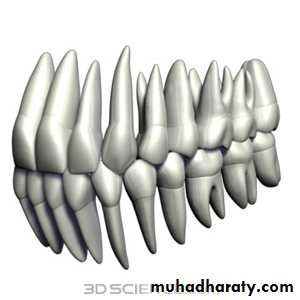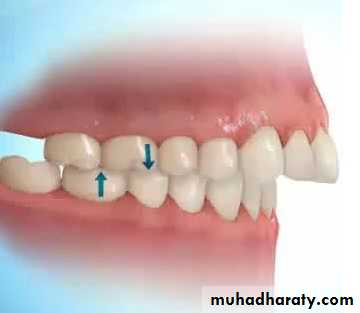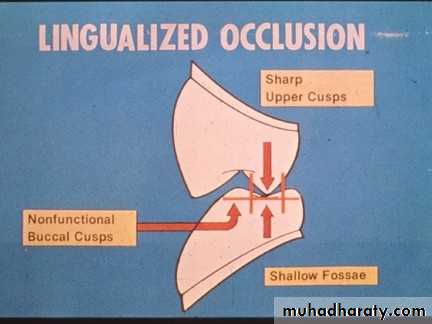Occlusal Schemes
Occlusion: the static relationship between the incising or masticating surfaces of the maxillary or mandibular teeth or tooth analogues.Occlusion
Angle’s classification of occlusion
Classification system of occlusion based on the interdigitation of the first molar teeth originally described by Angle as four major groups depending on the antero- posterior jaw relationship. Class IV is no longer in use.Class I (normal occlusion or neutrooclusion): the dental relationship in which there is normal anteroposterior relationship of the jaws, as indicated by correct interdigitation of maxillary and mandibular molars, but with crowding and rotation of teeth elsewhere, i.e., a dental dysplasia or arch length deficiency.
Class II (distoclusion): the dental relationship in which the mandibular dental arch is posterior to the maxillary dental arch in one or both lateral segments; the mandibular first molar is distal to the maxillary first molar.
Class II can be further subdivided into two divisions:
Division 1: bilateral distal retrusion with a narrow maxillary arch and protruding maxillary incisors. Subdivisions include right or left (unilaterally distal with other characteristics being the same).
Division 2: bilateral distal with a normal or square-shaped maxillary arch, retruded maxillary central incisors, labially malposed maxillary lateral incisors, and an excessive vertical overlap.
Subdivisions include right or left (unilaterally distal with other
characteristics the same).
Class III (mesioocclusion): the dental relationship in which the mandibular arch is anterior to the maxillary arch in one or both lateral segments; the mandibular first molar is mesial to the maxillary first molar. The mandibular incisors are usually in anterior cross bite. Subdivisions include right or left (unilaterally mesial with other characteristics the same).
Class IV: the dental relationship in which the occlusal relations of the dental arches present the peculiar condition of being in distal occlusion in one lateral half and in mesial occlusion in the other (no longer used).
Centric occlusion : the occlusion of opposing teeth when the mandible is in centric relation. This may or may not coincide with the maximal intercuspal position.
Centric relation: the most retruded physiologic relation of the mandible to the maxillae to and from which the individual can make lateral movements. It is a condition that can exist at various degrees of jaw separation. It occurs around the terminal hinge axis.
Centric position : the position of the mandible when the jaws are in centric relation.
Acquired eccentric relation : any eccentric relationship position of the mandible relative to the maxilla, whether conditioned or learned by habit, which will bring the teeth into contact .
Acquired occlusal position : the relationship of teeth in maximum intercuspation regardless of jaw position.
Bilateral balanced articulation: also termed balanced articulation, the bilateral, simultaneous anterior and posterior occlusal contact of teeth in centric and excentric positions.
working side contacts: contacts of teeth made on the side of the articulation toward which the mandible is moved during working movements.
working side condyle path: the path the condyle travels on the working side when the mandible moves in a lateral excursion.
Concepts of Natural Occlusion
• Balanced occlusion: In this theory, all teeth contact in maximum intercuspation and during eccentric mandibular movements.• Mutually protected occlusion: the molars did not contact during eccentric movement, but in maximum intercuspation they contacted while anterior teeth had no contact and posterior teeth protect anterior teeth.
• Group function occlusion: This type of occlusion occurs when all facial ridges of working side teeth contact the opposing dentition, while the non working side teeth do not contact.
Balanced Occlusion:
In maximum intercuspation: , there is contact between all maxillary & mandibular teeth , anterior, & posterior. In protrusive movement, there is contact between the incisal edge of the maxillary & mandibular teeth , anterior, & posterior. In lateral movement, the side toward which the mandible moves , is called the ( working side) ,the upper lingual cusps contact the lower cusps. The other side is called the (balancing side ) where the upper buccal , and lingual cusps contact the lower buccal and lingual cusps respectively. It is difficult to find balanced occlusion in natural teeth, it may be present but not in the majority of people.
• Concepts of Natural Occlusion
Mutually Protected Occlusion :
In maximum intercuspation, the posterior teeth protect the anterior teeth.In protrusion, the anterior teeth contact in the incisal edges protecting the canines, and posterior teeth which have no contact.In lateral movement, the upper & lower canines contact with each other, protecting the anterior, & posterior teeth. i.e. there is no contact between the anterior, & posterior teeth.• Concepts of Natural Occlusion
Group Function Occlusion :
The anterior& posterior teeth have full contact on the working side, while there is no contact on the non working, or balancing side. i.e. the occlusal lateral pressure is distributed to all the working side teeth.• Concepts of Natural Occlusion
Concepts of Artificial Occlusion
• Balanced Occlusion• Monoplane Occlusion
• Lingualized Occlusion
1. Balanced Occlusion (Cusp Occlusion ):the contact between the opposing surfaces of any two teeth occurs in three dimensions, These dimensions the width, length, and the depth of the occluding surface
• 1. Balanced Occlusion
ADVANTAGES OF BALANCED OCCLUSION:1 – Fenestration of food is easy.2 – Resists the rotation of the denture base.3 – Provides better esthetics.4 – Acts as a guide for proper jaw closure.
DISADVANTAGES OF BALANCED OCCLUSION:1 – More occlusal disharmony during setting which is difficult to adjust.2 – Increases horizontal forces.3 – Difficult to adapt to abnormal jaw relationship.
Concepts of Artificial Occlusion
2. Monoplane or Non anatomical occlusion
The arrangement of teeth by which they are positioned in a single plane.The maxillary, and mandibular teeth are arranged without vertical overlap.
The maxillary posterior teeth are set first, and the occlusal plane must fulfill certain requirements:
It should result in an occlusal plane that evenly divides the space between the maxillary, and mandibular ridge.
It should provide an occlusal plane that parallels the mean denture base foundation.
The plane should fall at the junction of the upper , and the middle thirds of the retromolar pads.
ADVANTAGES OF MONOPLANE OCCLUSION
• No lateral component can be generated with vertical closing, i.e. achieve stability.• Freedom in centric occlusion( the mandible is not locked in centric relation due to that there is no cusp, and the patient can move the jaw forward, and laterally.
• It is used in Class II, and III jaw relations.
• DISADVANTAGES OF MONOPLANE OCCLUSION
• Decreases chewing efficiency.
• Esthetic is affected in both anterior, and premolar regions.
• The anterior teeth can not be set in overbite, and overjet, they have to be set in almost edge to edge.
2. Monoplane or Non anatomical occlusion
3. Lingualized Articulation
This form of denture occlusion articulates the maxillary lingual cusps with the mandibular occlusal surfaces in centric working and nonworking mandibular positions.It is termed lingualized articulation because of the semantic terminology of American English, in which the inner cusps of maxillary and mandibular teeth are termed the lingual cusps , British English palatal cusp contact articulation
The only exception is a very slight mesio-distal adjustment of the lower posterior teeth, so that the upper palatal cusps contact the fossae of the lowers, and will not contact any lower marginal ridges
In excursive movements, the lower occlusal surfaces are adjusted so that contact with the upper palatal cusp is retained at all times
3. Lingualized Articulation
Advantages and Disadvantages of Lingualized Articulation
• This concept has been called “an occlusion for all reasons” and rightly so.• easier to make than with a fully balanced articulation using cusped teeth.
• this occlusal scheme is now frequently used in fixed implant prostheses.
• This concept has one disadvantage is when there may be an aesthetic imperative to provide well-defined buccal cusps in such a way that they must be involved in the articulations been called “an occlusion for all reasons” and rightly so.












